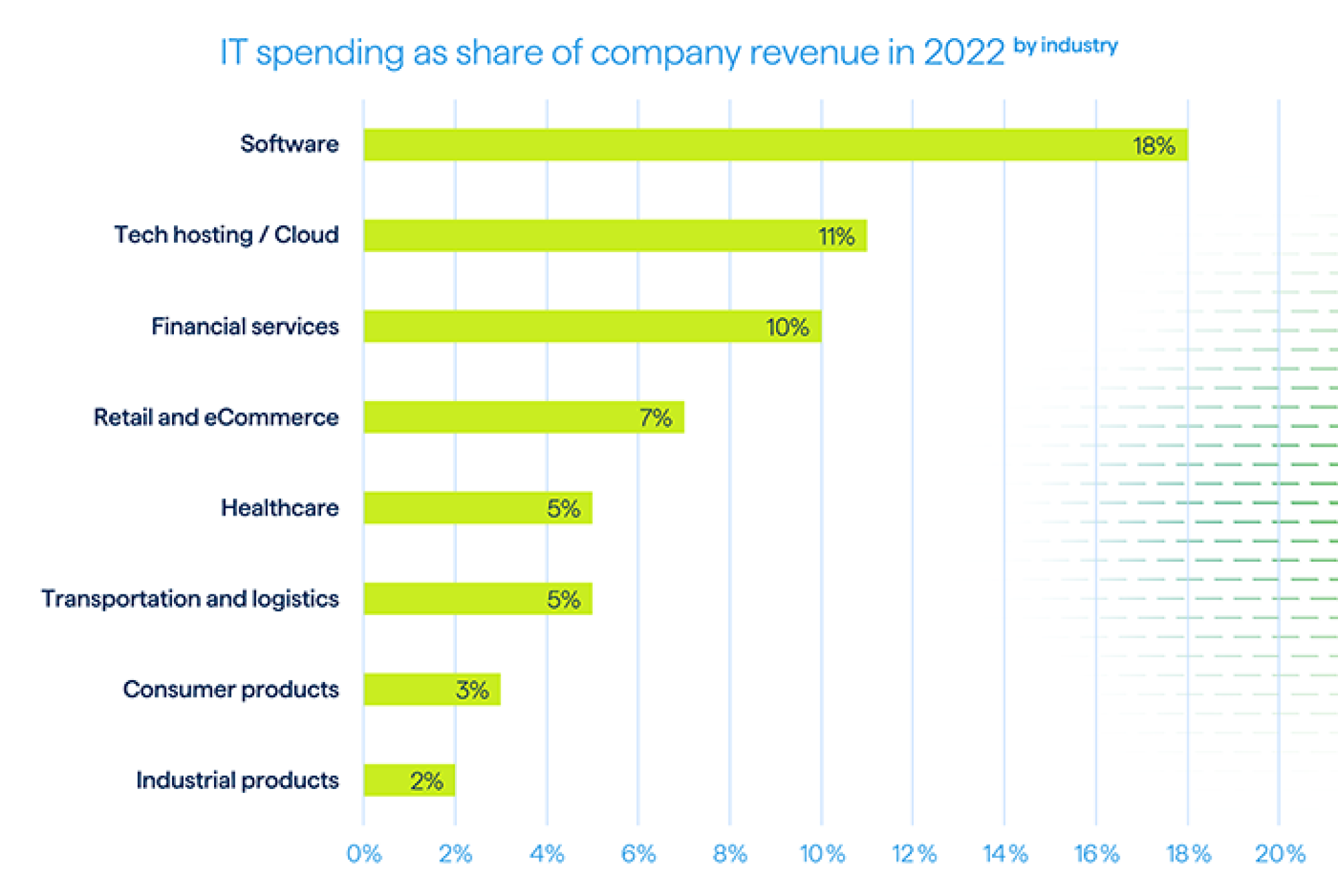According to the latest Gartner forecast, worldwide information technology (IT) spending is projected to total $5.1 trillion in 2024, an increase of 8% from 2023. What does that mean for your organization? Well, it depends on several factors, including what upcoming IT projects you have scheduled, the state of your business and IT investments, the size of your business, and much more.
Security will be a top concern in 2024, with 80% of CIOs reporting that they plan to increase spending on cyber/information security in the coming year. Due to the increase in the number of malicious actors looking to compromise data, security was listed as the top technology category for increased investment. Additional priorities for spending include data analysis, data privacy, Generative AI/machine learning, and customer experience.
The percentage of total revenue that you should reinvest in IT really depends on your industry. According to a Statista report, software companies invest the most at 19%, while industrial products companies typically reinvest only 2%.

What are the consequences of not investing in IT?
IT is a costly but necessary and beneficial investment. Up-to-date technology strengthens company infrastructure, boosts productivity, and increases efficiency to make work quicker and smoother. It also lowers security risks and helps prevent accidental losses, eliminating glitches or obstacles that can slow down or bring work to a halt. Additionally, it enables remote work and expansion around the world.
The Eastman Kodak Company is a well-known and harrowing example of when ignoring new technology, competition, and the market led to the downfall of the photography pioneer. The giant company once ruled the photography world, and it even invented the first digital camera in 1975. However, it dragged its feet on developing new technology, opting instead to protect its film business. Due to a combination of arrogance and “blind faith” in the power of marketing to persuade customers to ignore digital photography, Kodak refused to take advantage of its market leading position to pivot to digital.
By the time Kodak introduced its first digital camera, it was far behind the competition. Critics say its management had been complacent and overconfident about sustaining success. In 2012, the 133-year-old company filed for bankruptcy protection.
So, where do you start? We’ll give you a step-by-step plan.
Four steps to better quantify and execute IT spending
Step 1: Involve the whole CxO team in technology planning
When evaluating your IT budget, it’s important to ensure that your CIO and IT staff are aligned with the rest of the CxOs in the organization of priorities. According to Gartner, CIOs who co-lead and resource digital delivery teams end-to-end with their CxOs are more than twice as likely to meet or exceed the outcomes from their digital technology investments than are CIOs who leave the delivery of digital capabilities to their IT departments.
The most dangerous way to launch an IT initiative is to have a business executive announce that he or she wants to roll out a specific piece of technology. Although it’s easy for IT leaders to get excited when a business executive proclaims, “I want to launch Dynamics CRM at next year’s kickoff meeting”, or “we need a new mobile application for our millennial customers”, these simplistic, technology-focused objectives do not constitute the makings of a strategic IT project alone.
IT should create strategic business value across the organization. Technology buying teams are more likely to be highly motivated when a tech purchase addresses organization-level strategic goals. Those needs that sit at the initiative, or even business function level, are at risk of being sidelined unless they clearly affect the organization’s ability to achieve its strategic goals.
Step 2: Look for ways to eliminate wasteful IT spending
Many people these days have a half dozen or so subscriptions or recurring monthly charges that could and should be cut. Is it the same for your business? It’s important for CIOs to look for ways to cut or reduce spending by eliminating waste and redundancy.
Start by benchmarking and identifying functional or business areas that have cost variances that are significantly higher than vertical industry averages. For example, a seasonal business unit consuming significantly more capacity during peak periods presents an opportunity to reallocate or cut capacity when it isn’t needed during the rest of the year.
CIOs can redirect funds from areas that do not deliver meaningful business impact by:
- Proactively and programmatically reviewing and cutting spending that does not have a demonstrable impact on business outcomes. For example, outdated or duplicative monitoring and management tools maintained out of habit, rather than as a function of the value they provide, should be cut.
- Eliminating or reducing spending before it is committed by contract. That allows funds to be reinvested in projects that drive increased business value.
- Rightsizing hardware or, if in the cloud, cloud spending. Right sizing is the most effective way to control hardware or cloud costs. It involves continually analyzing instance performance and usage needs and patterns—and then turning off idle instances and right sizing instances that are either overprovisioned or poorly matched to the workload. Since your resource needs are always changing, right sizing must become an ongoing process to continually achieve cost optimization.
Step 3: Align IT spending with defined business outcomes
Mistakes occur when IT budgets are focused on individual general ledger line items, rather than on the larger enterprise goals. According to Gartner, buyer’s remorse occurs in 80% of enterprise technology decisions. That’s a big percentage!
So, how do you avoid purchasing pitfalls? By strategically aligning IT spending with desired business outcomes:
- View IT budgeting as part of the overall enterprise plan. Work closely with business unit leaders to understand how they will execute the objectives that come from the enterprise strategic planning process.
- Make IT budgets flexible and agile. This generally requires shifting fixed costs to variable costs, over time, and focusing on the prioritization and alignment of key spending initiatives, not individual line items.
- Leverage a solid business case process to ensure that all investments are driven by their value to the enterprise, and not by whether a particular spend is OpEx (operating expenditure) or CapEx (capital expenditure).
Explicitly negotiating intended business outcomes, technology selection criteria, and technology evaluation procedures prior to launch may not necessarily guarantee success, but it can significantly reduce the rate of failure.
Let’s look at a real-world example of a company that wants to grow with existing customers. What actions are they going to take to move the needle? Business outcomes must be measurable so that the company knows whether their tactics are effective in reaching their desired business outcomes. Typically, success is measured as a lagging indicator, looking at whether revenue went up or down, for example. If increasing revenue from existing customers is the goal, how much do you want it to increase, and over what period of time? A company may believe that more visits to a customer will result in increased revenue. But how many more visits will they need compared with today? Does the data show that increasing visits was effective, or does the company need to change course to grow with existing customers?
Step 4: Optimize performance by improving efficiency and productivity
When building your IT budget, it’s important to focus on ways to boost efficiency and productivity. Improving efficiency means focusing IT teams on doing what they currently do better, with fewer resources, or by shifting resources to differentiating activities and supporting the business to do the same. For example, that might entail finding ways of processing more support tickets or service requests with less human effort.
To increase productivity, find ways to use existing resources to perform higher value and differentiating work, or to shift effort and expenditure from lower-value to higher-value business work. Automating workflows to reduce or eliminate human involvement in the process is one example of that.
What ROI can you expect from your technology investment?
Return on investment (ROI) is a performance measure used to evaluate the efficiency or profitability of an investment, or to compare the efficiency of a number of different investments. Also known as a digital transformation cost benefit analysis, ROI seeks to measure the amount of return on a particular investment directly, relative to the investment’s cost.
To calculate ROI, the benefit (or return) of an investment is divided by the cost of the investment. The result is expressed as a percentage or ratio.
For example, you’re moving your on-premises software to the cloud, and you want to calculate the potential ROI. To do so, you can use the following equation:
Total on-premises cost over 5 years - Total cloud cost over 5 years) / Total cloud cost over 5 years
As a quick example, the total on-premises cost over 5 years would be $98,353, and the total cloud cost over 5 years would be $13,353. That indicates that the ROI would be:
($98,353 - $13,353) / $13,353 or 637%
In other words, every dollar you spent on the cloud in that scenario would save you $6.37, compared to your on-premises costs, assuming the $98,353 on-premises cost, and the $13,353 cloud cost used in the example.
IT budgets can be overwhelming and depend on a number of different internal and external factors. By involving the entire organization, shifting your mindset to desired business outcomes, focusing on improved efficiency and productivity, and eliminating wasteful spending, you can be well on your way to making the right decisions and spending your money wisely.
We’re here to help guide you through your IT investment decisions. Reach out to one of our experts by clicking here.
